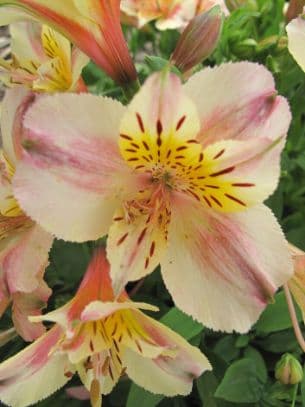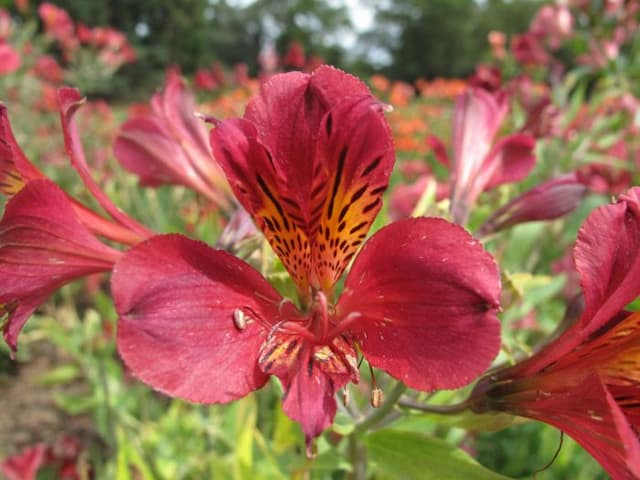Peruvian Lily Alstroemeria 'Avanti'

ABOUT
The Alstroemeria 'Avanti', also known as the Peruvian Lily or Lily of the Incas, is a striking and colorful perennial plant. It is well-regarded for its vibrant flowers, which are often used in cut flower arrangements. These blossoms exhibit a fascinating array of colors, typically featuring shades of orange, red, and yellow, and are marked with distinctive streaks and fleck patterns that contribute to their exotic look. Each flower has six petals, and they often bear a resemblance to miniature lily flowers, hence the common name. The foliage of Peruvian Lily 'Avanti' consists of narrow, lance-shaped, green leaves that grow in an upright fashion and add a lush, dense backdrop for the starry blooms. The leaves may also display a slight twist or curvature that adds texture to the overall appearance of the plant. The blossoms form at the top of tall, slender stems that emerge from clumps of this leafy greenery. This variety of Peruvian Lily tends to bloom profusely, offering a long-lasting display that can bring cheer to any garden setting throughout its blooming season. The plant's flowers and leaves combine to create a bushy and full appearance that is visually pleasing whether planted in garden beds, borders, or containers.
About this plant
 Names
NamesFamily
Alstroemeriaceae.
Synonyms
Peruvian Lily, Lily of the Incas, Parrot Lily, Peruvian Lily 'Avanti'.
Common names
Alstroemeria 'Avanti'
 Toxicity
ToxicityTo humans
The Peruvian lily is generally considered non-toxic to humans. However, it can cause mild irritation to sensitive individuals, especially when handling the plant without gloves, as the sap may cause dermatitis in some people. Ingesting parts of the plant is not typically associated with serious poisoning, but it could potentially result in gastrointestinal discomfort or irritation.
To pets
The Peruvian lily is considered to be mildly toxic to cats and dogs. If pets ingest this plant, symptoms of poisoning may include vomiting, diarrhea, and drooling. In most cases, the toxicity is relatively low, and serious complications are rare. However, if a pet consumes a large amount of the plant, or if symptoms persist, it is advisable to contact a veterinarian.
 Characteristics
CharacteristicsLife cycle
Perennials
Foliage type
Deciduous
Color of leaves
Green
Flower color
Mixed
Height
2-3 feet (60-90 cm)
Spread
2 feet (60 cm)
Plant type
Herb
Hardiness zones
7
Native area
South America
Benefits
 General Benefits
General Benefits- Long-Lasting Blooms: Alstroemeria 'Avanti', commonly known as the Peruvian Lily, is highly valued for its long-lasting flowers that can remain in bloom for several weeks.
- Vibrant Colors: Offers a wide range of vibrant colors and unique patterns that can brighten up any garden or floral arrangement.
- Cut Flower Use: Excellent for use in bouquets and arrangements due to its sturdy stems and long vase life, making it a favorite among florists.
- Attracts Pollinators: Its nectar-rich flowers attract bees, butterflies, and hummingbirds to the garden, supporting local ecosystems.
- Low Maintenance: Requires minimal care once established, making it suitable for gardeners of all skill levels.
- Drought Tolerance: Once established, it has good drought tolerance, making it suitable for water-wise gardens in suitable climates.
- Good for Containers: Can be grown in containers, which is ideal for those with limited garden space or who wish to decorate patios and balconies.
 Medical Properties
Medical PropertiesThis plant is not used for medical purposes.
 Air-purifying Qualities
Air-purifying QualitiesThis plant is not specifically known for air purifying qualities.
 Other Uses
Other Uses- As a natural dye source: The petals of the Alstroemeria, or Peruvian lily, can be used to produce a natural dye for fabrics, offering a range of colors from yellows to pinks, depending on the processing.
- Insectary plant in gardens: Peruvian lilies can be used to attract beneficial insects to the garden, such as bees and butterflies, which can help with pollination of surrounding plants.
- Floral photography: The Peruvian lily's intricate patterns and vibrant colors make it a popular subject for photographers looking to capture the beauty of flowers in their art.
- Eco-friendly confetti: Dried petals of the Peruvian lily can be used as biodegradable confetti for outdoor celebrations, reducing environmental impact.
- Book pressing: The sturdy petals of Peruvian lilies are suitable for pressing and preserving in books, often used in crafts or as bookmarks.
- Edible garnish: While not commonly consumed, the petals of Alstroemeria can be used as an edible garnish for sophisticated dishes, after ensuring they are free from pesticides.
- Creative crafts: The colorful petals and leaves of Peruvian lilies can be used in crafting, such as making handmade paper or floral decoupage projects.
- Petal pathways: During events, the petals of the Peruvian lily can be sprinkled on walkways to create decorative and fragrant pathways.
- Fragrance extraction: Although not a common practice, the subtle fragrance of Peruvian lily flowers can be used to make floral waters or perfumes.
- Teaching botany: Alstroemeria 'Avanti' can serve as an educational tool for teaching plant biology, particularly the morphology of monocots versus dicots.
Interesting Facts
 Feng Shui
Feng ShuiThe Peruvian Lily is not used in Feng Shui practice.
 Zodiac Sign Compitability
Zodiac Sign CompitabilityThe Peruvian Lily is not used in astrology practice.
 Plant Symbolism
Plant Symbolism- Friendship - Alstroemeria, commonly known as Peruvian Lily or Lily of the Incas, often represents strong bonds between friends due to its lasting blooms.
- Wealth - The multiple colors of the Peruvian Lily are sometimes associated with prosperity and fortune.
- Devotion - With its intricate patterns and markings, the Peruvian Lily can symbolize a committed and enduring relationship.
- Achievement - The growth habit and success of the plant in blooming can represent striving forward and achieving personal success.
- Perseverance - The hardiness and resilience of the Peruvian Lily suggest a sense of determination and the ability to push through challenges.
 Water
WaterPeruvian Lily should be watered regularly to maintain moist but not waterlogged soil, especially during spring and summer when the plant is actively growing. Check the top inch of the soil for dryness every few days and water thoroughly when needed. This could translate to approximately 1-2 gallons per week, depending on environmental conditions such as temperature and humidity. During winter, reduce watering to prevent root rot, providing enough to prevent the soil from completely drying out.
 Light
LightPeruvian Lily thrives best in full sun to partial shade. It should be placed in a spot where it can receive at least 6 hours of direct sunlight daily. However, in hot climates, providing afternoon shade will help protect the blooms and foliage from intense sun.
 Temperature
TemperatureThe Peruvian Lily can tolerate a wide range of temperatures but grows best at temperatures between 65 and 80 degrees Fahrenheit. It can survive minimum temperatures down to about 24 degrees Fahrenheit, but frost can severely damage the plant. Ideal growing conditions avoid extreme heat as well as harsh frosts.
 Pruning
PruningPruning Peruvian Lily encourages healthy growth and rejuvenates the plant. After the first killing frost in the fall, prune back the foliage to ground level. Throughout the growing season, regular removal of spent flowers and dead leaves will promote further blooming and prevent disease.
 Cleaning
CleaningAs needed
 Soil
SoilThe ideal soil mix for Peruvian lily (Alstroemeria 'Avanti') should be fertile, well-draining, and slightly acidic to neutral with a pH range of 6.0 to 7.0. A mixture of two parts loam, one part peat, and one part perlite or sand can provide the right conditions for healthy growth.
 Repotting
RepottingPeruvian lily should be repotted every two to three years to refresh the soil and accommodate its root growth. However, this plant prefers to be left undisturbed if possible, so repotting should be done carefully.
 Humidity & Misting
Humidity & MistingPeruvian lily thrives in moderate humidity levels, typically around 40-60%. They do not require extremely high humidity but should not be placed in overly dry environments.
 Suitable locations
Suitable locationsIndoor
Place Peruvian lily in bright, indirect light, ensuring soil stays moist.
Outdoor
Plant in partial sun, protect from harsh conditions, and water regularly.
Hardiness zone
7-10 USDA
 Life cycle
Life cycleThe Peruvian Lily 'Avanti' begins its life cycle as a dormant underground rhizome. Upon favorable spring conditions, it germinates, sending up shoots that develop into lush foliage and stems. As the plant matures, it produces distinctive trumpet-shaped flowers, often marked with streaks and spots, through the spring and summer. After pollination, typically by bees, the flowers develop into dry capsules containing seeds. Once the growing season ends, the plant's aerial parts die back, and it enters a period of dormancy through the colder months. The cycle resumes the following spring, with the rhizome sprouting new growth and continuing the perennial life cycle.
 Propogation
PropogationPropogation time
Spring to Early Summer
Alstroemeria 'Avanti', commonly known as Peruvian Lily, is best propagated by division. The ideal time to divide Peruvian Lily tubers is in the late winter or early spring when the plant is dormant and before new growth starts. Begin by gently digging up the clump of tubers, taking care not to damage them. Once you have the clump out of the ground, brush off the soil and carefully separate the tubers. Each piece should have at least one eye, which is a growth point from which new shoots will emerge. Plant the divisions at the same depth they were previously growing, typically about 6 to 8 inches (15 to 20 centimeters) apart to allow enough room for growth. Water the new divisions thoroughly and wait for them to establish and grow into new, healthy plants.

![Peruvian lily [Princess Carmina]](/_next/image?url=https%3A%2F%2Fplants-admin.emdemapps.com%2Fimages%2Fplants%2F%2Fimages%2F604b5b436505f.png&w=640&q=75)


![Peruvian lily [Inca Glow]](/_next/image?url=https%3A%2F%2Fplants-admin.emdemapps.com%2Fimages%2Fplants%2F%2Fimages%2F604b5e99e48d9.png&w=640&q=75)
![Peruvian lily [Inca Smile]](/_next/image?url=https%3A%2F%2Fplants-admin.emdemapps.com%2Fimages%2Fplants%2F%2Fimages%2F604b5cad8fa91.png&w=640&q=75)
![Peruvian lily [Inticancha Passion]](/_next/image?url=https%3A%2F%2Fplants-admin.emdemapps.com%2Fimages%2Fplants%2F%2Fimages%2F604b5f7a78c8d.png&w=640&q=75)


